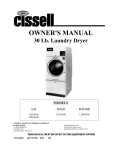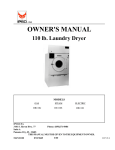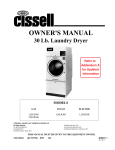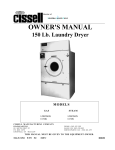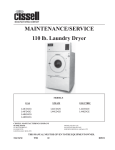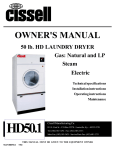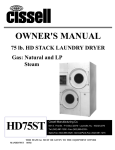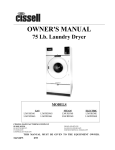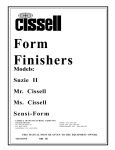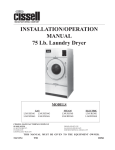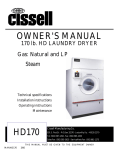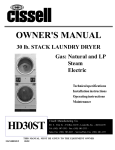Download Cissell L36US30 Specifications
Transcript
R1 2/07 IMPORTANT NOTICES—PLEASE READ For optimum efficiency and safety, we recommend that you read the Manual before operating the equipment. Store this manual in a file or binder and keep for future reference. WARNING: For your safety, the information in this manual must be followed to minimize the risk of fire or explosion or to prevent property damage, personal injury, or loss of life. - Do not store or use gasoline or other flammable liquids or vapors in the vicinity of this or any other appliance. - WHAT TO DO IF YOU SMELL GAS • Do not try to light any appliances. • • Do not touch any electrical switch; do not use any phone in your building. Clear the room, building, or area of all occupants. • Immediately call your gas supplier from a neighbor's phone. Follow the gas supplier's instructions. • If you cannot reach the gas supplier, call the fire department. Installation and service must be performed by a qualified installer, service agency or the gas supplier. WARNING: In the event the user smells gas odor, instructions on what to do must be posted in a prominent location. This information can be obtained from the local gas supplier. WARNING: Wear Safety Shoes to prevent injuries. WARNING: Purchaser must post the following notice in a prominent location: FOR YOUR SAFETY Do not store or use gasoline or other flammable vapors and liquids in the vicinity of this or any other appliance. WARNING: A clothes dryer produces combustible lint and should be exhausted outside the building. The dryer and the area around the dryer should be kept free of lint. WARNING: Be safe, before servicing machine, the main power should be shut off. Page 2 WARNING: To avoid fire hazard, do not dry articles containing foam rubber or similar texture materials. Do not put into this dryer flammable items such as baby bed mattresses, throw rugs,undergarments (brassieres, etc.) and other items which use rubber as padding or backing. Rubber easily oxidizes causing excessive heat and possible fire. These items should be air dried. WARNING: Synthetic solvent fumes from drycleaning machines create acids when drawn through the dryer. These fumes cause rusting of painted parts, pitting of bright or plated parts, and completely removes the zinc from galvanized parts, such as the tumbler basket. If drycleaning machines are in the same area as the tumbler, the tumbler's make-up air must come from a source free of solvent fumes. WARNING: Do not operate without guards in place. WARNING: Check the lint trap often and clean as needed but at least a minimum of once per day. WARNING: Alterations to equipment may not be carried out without consulting with the factory and only by a qualified engineer or technician. Only Cissell parts may be used. WARNING: Remove clothes from dryer as soon as it stops. This keeps wrinkles from setting in and reduces the possibility of spontaneous combustion. WARNING: Be Safe - shut main electrical power and gas supply off externally before attempting service. WARNING: Never use drycleaning solvents, gasoline, kerosene, or other flammable liquids in the dryer. FIRE AND EXPLOSION WILL OCCUR. NEVER PUT FABRICS TREATED WITH THESE LIQUIDS INTO THE DRYER. NEVER USE THESE LIQUIDS NEAR THE DRYER.. WARNING: Never let children play near or operate the dryer. Serious injury could occur if a child should crawl inside and the dryer is turned on. WARNING: Never tumble fiberglass materials in the dryer unless the labels say they are machine dryable. Glass fibers break and can remain in the dryer. These fibers cause skin irritation if they become mixed with other fabrics. WARNING: Before operating gas ignition system - purge air from Natural Gas or Propane Gas Lines per manufacturer’s instructions.. Page 3 CISSELL DRYER WARRANTY The Cissell Manufacturing Company (Cissell) warrants all new equipment (and the original parts thereof) to be free from defects in material or workmanship for a period of two (2) years from the date of sale thereof to an original purchaser for use, except as hereinafter provided. With respect to non-durable parts normally requiring replacement in less than two (2) years due to normal wear and tear, and with respect to all new repair or replacement parts for Cissell equipment for which the two (2) year warranty period has expired, or for all new repair or replacement parts for equipment other than Cissell equipment, the warranty period is limited to ninety (90) days from date of sale. The warranty period on each new replacement part furnished by Cissell in fulfillment of the warranty on new equipment or parts shall be for the unexpired portion of the original warranty period on the part replaced. With respect to electric motors, coin meters and other accessories furnished with the new equipment, but not manufactured by Cissell, the warranty is limited to that provided by the respective manufacturer. Cissell’s total liability arising out of the manufacture and sale of new equipment and parts, whether under the warranty or caused by Cissell’s negligence or otherwise, shall be limited to Cissell repairing or replacing, at its option, any defective equipment or part returned f.o.b. Cissell’s factory, transportation prepaid, within the applicable warranty period and found by Cissell to have been defective, and in no event shall Cissell be liable for damages of any kind, whether for any injury to persons or property or for any special or consequential damages. The liability of Cissell does not include furnishing (or paying for) any labor such as that required to service, remove or install; to diagnose troubles; to adjust, remove or replace defective equipment or a part; nor does it include any responsibility for transportation expense which is involved therein. The warranty of Cissell is contingent upon installation and use of its equipment under normal operating conditions. The warranty is void on equipment or parts; that have been subjected to misuse, accident, or negligent damage; operated under loads, pressures, speeds, electrical connections, plumbing, or conditions other than those specified by Cissell; operated or repaired with other than genuine Cissell replacement parts; damaged by fire, flood, vandalism, or such other causes beyond the control of Cissell; altered or repaired in any way that effects the reliability or detracts from its performance, or; which have had the identification plate, or serial number, altered, defaced, or removed. No defective equipment or part may be returned to Cissell for repair or replacement without prior written authorization from Cissell. Charges for unauthorized repairs will not be accepted or paid by Cissell. CISSELL MAKES NO OTHER EXPRESS OR IMPLIED WARRANTY, STATUTORY OR OTHERWISE, CONCERNING THE EQUIPMENT OR PARTS INCLUDING, WITHOUT LIMITATION, A WARRANTY OF FITNESS FOR A PARTICULAR PURPOSE, OR A WARRANTY OF MERCHANTABILITY. THE WARRANTIES GIVEN ABOVE ARE EXPRESSLY IN LIEU OF ALL OTHER WARRANTIES, EXPRESS OR IMPLIED. CISSELL NEITHER ASSUMES, NOR AUTHORIZES ANY PERSON TO ASSUME FOR IT, ANY OTHER WARRANTY OR LIABILITY IN CONNECTION WITH THE MANUFACTURE, USE OR SALE OF ITS EQUIPMENT OR PARTS. For warranty service, contact the Distributor from whom the Cissell equipment or part was purchased. If the Distributor cannot be reached, contact Cissell. IDENTIFICATION NAMEPLATE The Identification Nameplate is located on the rear wall of the dryer. It contains the dryer serial number, product number, model number, electrical specifications and other important data that may be needed when servicing and ordering parts, wiring diagrams, etc. Do not remove this nameplate. Page 4 TABLE OF CONTENTS 110 LB. LAUNDRY DRYER INSTALLATION/OPERATION MANUAL PAGE Model Numbers & Company Address................................................................................. 1 Important Notices ............................................................................................................. 2-3 Dryer Warranty ................................................................................................................... 4 Table of Contents ................................................................................................................ 5 Warnings, Cautionary Notes and Symbols........................................................................ 6-7 Unpacking and General Insulation ....................................................................................... 8 Disassembling Top of Dryer ............................................................................................... 9 Gas Heated Dryer Illustration ........................................................................................... 10 Steam Heated Dryer Illustration ........................................................................................ 11 Electric Dryer Illustration ................................................................................................. 12 Gas Fired Dryer Illustration .............................................................................................. 13 Specifications............................................................................................................... 14-16 Electrical Connections ...................................................................................................... 17 Gas Piping ......................................................................................................................... 18 Gas Piping and Gas Loop Piping Installation .................................................................... 19 Gas Pipe Size Chart .......................................................................................................... 20 Gas Piping Installation ...................................................................................................... 21 Steam Piping Installation .............................................................................................. 22-23 Exhaust Installation - Multiple Manifold Duct ............................................................. 24-26 Exhaust Installation with Separate Exhaust ....................................................................... 27 Dryer Air Flow Installation............................................................................................... 28 Rules for Safe Operation ................................................................................................... 29 Energy Saving Tips ........................................................................................................... 30 Two Timer Model Operation Instructions .................................................................... 31-33 Service Savers .................................................................................................................. 34 Troubleshooting ........................................................................................................... 35-38 Page 5 SYMBOLS The following symbols are used in this manual and/or on the machine. The numbers between () refer to the numbers on the machine surveys. Symbol Description NOTE! Hot! Do Not Touch Heiß! Nicht Beruhren Haute temperature! Ne pas toucher Caliente! no tocar dangerous voltage tension dangereuse Gefährliche elektrische Spannung tension peligrosa on marche Ein conectado off arrêt Aus desconectado start demarrage Start arranque de un movimiento emission of heat in general êmission de chaleur en general Warmeabgabe allgemein emisión de calor cooling refroidissement Kühlen enfriamiento Page 6 Part/Measurement SYMBOLS Symbol Description rotation in two directions rotation dans les deux sens Drehbewigung in zwei Richtungen movimiento rotativo en los dos sentidos direction of rotation sens de mouvement continu de rotation Drehbewegung in Pfeilrichtung movimiento giratorio o rotatorio en el sentido de la flecha End of Cycle caution attention Achtung atencion; precaucion Page 7 Part/Measurement UNPACKING Unpacking/General Installation (All Dryers) All Cissell dryers are packed in a protective (heavy-duty) plastic bag. Upon arrival of the equipment, any damage in shipment should be reported to the carrier immediately. Upon locating permanent location of a unit, care should be taken in movement and placement of equipment. See outline clearance diagrams for correct dimensions. Remove all packing material such as: tape, manuals, skid, etc. On gear reducer models, remove screw and insert vent found in basket. Leveling: Use spirit level on top of dryer. Adjust leveling bolts on dryer (see adjustable leveling bolts in maintenance section). Check voltage and amperes on rating plate before installing the dryer. GENERAL INSTALLATION (ALL DRYERS) The construction of Cissell dryers permits installation side-by-side to save space or to provide a wall arrangement. Position dryer for the least amount of exhaust piping and elbows, and allow free access to the rear of dryer for future servicing of belts, pulleys and motors. Installation clearance from all combustable material is 12” ceiling clearance, 24” rear clearance, and 0” side clearance. Before operating dryer, open basket door and remove blocking between front panel and basket. Read the instruction tags, owner's manual, warnings, etc. IMPORTANT Opening the clothes loading door deactivates the door switch to shut off the motors, fan, gas, steam, or electric element. To restart the dryer, close the door and press in the push to start button and hold briefly. IMPORTANT This dryer is designed for a capacity maximum load. Overloading it will result in long drying times and damp spots on some clothes. IMPORTANT Maximum operating efficiency is dependent upon proper air curculation. The lint screen must be kept cleaned daily to insure proper air circulation throughout the dryer. IMPORTANT Provide adequate clearance for air opening into the combustion chamber. Page 8 Disassembling Top of Dryer PROCEDURE FOR DISASSEMBLING TOP OF 110 LB. GAS LAUNDRY DRYERS 1. Shut off main gas supply and electrical power. Disconnect bonnet gas supply line at union fitting. 2. Unscrew two (2) top front cover panel hold down screws and open front cover panel. If wires enclosed are not color coded or number matched, match mark before disconnecting or removing. 3. In the left hand control box, disconnect the two (2) multi-wire connector plugs. Unscrew two (2) hold down bolts from the bottom of the box and one (1) bolt outside the rear of the box. Remove the two (2) screws that hold the conduit plate to the control box. Now remove the box. 4. In the right hand control box, unscrew one (1) screw at the top of the control panel and swing panel forward. Disconnect two (2) multi-wire connector plugs. Unscrew two (2) hold down bolts from bottom of box and one (1) bolt outside the box at the rear. 5. Replace two (2) top front cover panel hold down screws and remove entire control panel assembly. 6. Disconnect exhaust duct at bonnet enclosure assembly. (Only applies to energy-saver models “F” and “R”.) 7. Unscrew hold down screws from bonnet enclosure assembly (energy-saver models only). Unscrew bonnet hold down bolts. Remove air switch box cover on rear of dryer, disconnect one (1) yellow wire from air switch, one (1) black wire at cigarette connector and remove one (1) conduit nut. The entire bonnet and enclosure assembly can now be removed from top of dryer. 8. To reassemble, reverse disassembly procedure. Page 9 110 lb. Gas Fired Dryer—Models L44CD42G and L44KD42G (Illustration) Page 10 110 lb. Steam Heated Dryer—Models L44CD42S and L44KD42S (Illustration) Page 11 110 lb. Electric Dryer—Model L44CD42E (Illustration) Page 12 110 lb. Gas Fired Dryer—Models L44FD42G and L44RD42G (Illustration) ENERGY-SAVER MODEL Page 13 Specifications GENERAL SPECIFICATIONS FOR 110 lb. GAS FIRED, STEAM HEATED AND ELECTRIC LAUNDRY DRYERS GAS FIRED DRYERS ONLY CONSULT GAS SUPPLIER FOR SPECIFIC GAS REQUIREMENTS Floor Space ...............................................67” Deep x 47” W x 89-1/8” H (Gas, Electric, 4-Coil Steam, ...................(163 cm x 119 cm x 6-Coil Steam) ...........................................227 cm) Door ..........................................................31-1/4” diameter (79.38 cm) Basket Size ................................................44” diameter x 42” Deep ...................................................................(112 cm x 107 cm) Basket Load Capacity ................................110 lbs. (49.9 kg) dryweight Basket Motor.............................................1 HP Fan Motor ..................................................1 1/2 HP Basket RPM Reversing ................................................28 (3.2 reversals per minute) Non-Reversing ........................................34 Exhaust Duct .............................................12” diameter (30.48 cm) Maximum Air Displacement Steam-Gas ...............................................2160 CFM (61.16 M³/Min.) Electric ....................................................2250 CFM (63.71 M³/Min.) Recommended Operating Range Steam-Gas ...............................................1900-2100 CFM (53.80-59.46 ...................................................................M³/Min.) Electric ....................................................2000-2200 CFM (56.63-62.30 ...................................................................M³/Min.) Net Weight (approximate) Steam .......................................................1640 lbs. (743.89 kg) Gas & Electric ........................................1590 lbs. (721.21 kg) Domestic Shipping Weight Steam - 1 crate (approx.) .......................2135 lbs. (968.42 kg) Gas - 1 crate (approx.) ...........................2065 lbs. (936.67 kg) Electric - 1 crate (approx.).....................2034 lbs. (922.61 kg) Export Shipping Weight Steam - 1 box (approx.) ..........................2450 lbs. (111.3 kg) Gas - 1 box (approx.) .............................2330 lbs. (1056.87 kg) Electric - 1 box (approx.) .......................2300 lbs. (1043.26 kg) Export Shipping Dimensions ....................93” L x 53” W x 78” H -232.7 cu. ft. (236 cm x 135 cm x 198 cm) - (6.59 m³) BTU Input Rating .......................................250,000 BTU per hour (nat., mixed and mfg. gases) 250,000 per hour (propane and butane gases) Gas Supply .................................................1” (1.91 cm) pipe connection Electric Ignition ........................................Silicon Carbide Gas Ignition System Manifold Gas Pressure .............................3.5” WC Max. (Nat. Gas); 11” WC (LP Gas) Drying Time ..............................................110 lbs. (49.9 kg) (Indian Head) dry weight (Approximate - testing in laboratory) ........................................70% water retention - 38 min 50% water retention - 28 min. Page 14 Specifications STEAM HEATED DRYERS ONLY Operating Steam Pressure 4-Coil .................................................. 100 PSIG Max. 6-Coil .................................................. 100 PSIG Max. Boiler HP (with normal load) 4-Coil .................................................. 7.87 6-Coil .................................................. 9.50 Heat Capacity 4-Coil 6-Coil Steam Coils 4-Coil .................................................. (2) 40 1/2” L x 6” W x 10 1/4” H (102.87 cm x 15.24 cm x 26.04 cm) 6-Coil .................................................. (2) 40 1/2” L x 15 3/4” H x 6” W (2) 102.87 cm x 15.24 cm x 40.01 cm) Traps for Steam Heating Coils 4-Coil .................................................. 3/4” (1.91 cm) (2) 6-Coil .................................................. 3/4” (1.91 cm) (2) Steam Supply Line 4-Coil .................................................. 3/4” (1.91 cm) 6-Coil .................................................. 3/4” (1.91 cm) Steam Return Line 4-Coil .................................................. 3/4” (1.91 cm) 6-Coil .................................................. 3/4” (1.91 cm) Drying Time .......................................... 110 lbs. (49.9 kg) dry weight (Approx. - testing in lab.) ...................... Indian Head cloth 4-Coil .................................................... High Pressure (100 PSIG Max.) 70% water retention - 38 min. 6-Coil .................................................... High Pressure (100 PSIG Max.) 70% water retention - 31 min. (Low Pressure requires longer drying time) 4-Coil .................................................. 50% water retention - 28 min. 6-Coil .................................................. 50% water retention - 24 min. ELECTRIC LAUNDRY DRYER (see Electric Bonnet Sheet) Drying Time (Dry Weight) 60 KW .................................................. 110 lbs. (49.9 kg) Indian Head cloth 80 KW .................................................. 110 lbs. (49.9 kg) Indian Head cloth (Approx. - testing in lab.) 60 KW .................................................. 70% water retention - 40 min. 50% water retention - 30 min. 80 KW .................................................. 70% water retention - 31 min. 50% water retention - 23 min. Page 15 Specifications ENERGY SAVER GAS DRYERS Floor Space ...................................................... 66” Deep x 47” W x 89 1/8” H (Gas, Electric, 4-Coil Steam, .......................... (167.64 cm x 119.38 cm x 6-Coil Steam) .................................................. 226.52 cm) Exhaust Duct .................................................... 8” diameter (20.32 cm) Maximum Air Displacement ............................ 850cu.ft.permin.(24.07M³/Min.) Recommended Operating Range ...................... 700-800 CFM (19.8-22.7 M³/Min.) BTU Input Rating .............................................. 200,000 per hour (nat., mixed and mfg. gases) 200,000 per hour (propane and butane gases) Net Weight (approx.) 50 Cy. ............................................................. 1720 lbs. (780.18 kg) 60 Cy. ............................................................. 1670 lbs. (757.5 kg) Domestic Shipping Weight (1 crate - approx.) 50 Cy. ............................................................. 2215 lbs. (780.18 kg) 60 Cy. ............................................................. 2165 lbs. (982.02 kg) Export Shipping Weight (1 crate - approx.) 50 Cy. ............................................................. 2430 lbs. (1102.23 kg) 60 Cy. ............................................................. 2380 lbs. (1079.55 kg) Export Shipping Dimensions ........................... 96” L x 49” W x 75” H (243.84 cm x 124.46 cm x 190.5 cm) Export Crating .................................................. 204.2 cu. ft. (5.78 M3) MOTORS USED - ALL 110 lb. DRYERS Motor No. Voltage Hz. Phase HP Basket or Fan Motor MTR212 208-230/460 60 3 1 Basket 3.8/1.9 MTR101 575 60 3 1 Basket 1.7 MTR104 240/415 50 3 1 Basket 3.0/1.6 MTR192 220/380 50 3 1 Basket 3.3/1,9 MTR192 220/380 60 3 1 Basket 3.1/1.8 MTR192 200/346 50 3 1 Basket 3.3/1.9 MTR215 200-230/460 60 3 1 1/2 Fan 5.6/2.8 MTR100 575 60 3 1 1/2 Fan 2 MTR192 240/415 50 3 1 1/2 Fan 5.8/3.2 MTR61 220/380 50 3 1 1/2 Fan 4.8/2.8 MTR61 220/380 60 3 1 1/2 Fan 4.3/2.5 MTR61 200/346 50 3 1 1/2 Fan 4.9/2.9 Totalcontrolsondryer,otherthanmotorsandelectricheatingelementsare1to3Amperes. Page 16 Motor Amps Electrical Connections (with Grounding Instructions Illustration) ELECTRICAL CONNECTIONS FOR ALL DRYERS Dryers must be electrically grounded by a separate #14 or larger green wire from the grounding terminal within the service connection box, to a cold water pipe. In all cases, the grounding method must comply with local electrical code requirements; or in the absence of local codes, with the National Electrical Code as ANSI/NFPA No. 70—Latest Edition. See wiring diagram furnished with dryer. Your Cissell dryer is completely wired at the factory and it is only necessary for the electrician to connect the power leads to the wire connectors within the service connection box on the rear of the dryer. Do not change wiring without consulting the factory, as you may void the factory warranty. DO NOT CONNECT THE DRYER TO ANY VOLTAGE OR CURRENT OTHER THAN THAT SPECIFIED ON THE DRYER RATING PLATE. (Wiring diagram is located on rear wall of dryer.) All panels must be in position before operation of dryer. Page 17 Gas Piping GAS SERVICE INSTALLATION INFORMATION The size of the gas service pipe is dependant upon many variables, such as tees, lengths, etc. Specific pipe size should be obtained from the gas supplier. Refer to the Gas Pipe Size Chart in this manual for general gas pipe size information. CAUTION Gas loop piping must be installed as shown in Illustration, to maintain equal gas pressure for all dryers connected to a single gas service. Other gas using appliances should be connected upstream from the loop. WARNING (LIQUIFIED PETROLEUM GASES ONLY) A Gas Pressure Regulator for Liquified Petroleum Gases is not furnished on Cissell Gas Heated Clothes Dryers. This regulator is normally furnished by the installer. In accordance with American Gas Association (AGA) standards, a gas pressure regulator, when installed indoors, must be equipped with a vent limiter, or a vent line must be installed from the gas pressure regulator vent to the outdoors. Page 18 Gas Loop Piping and Gas Supply Piping System (Illustrations) Page 19 Gas Pipe Size Chart TOTAL BTU/HR (for LP Gas correct total BTU/HR below by multiplying by .6) GAS PIPE SIZE FOR 1000 BTU (250 KCAL) NATURAL GAS AT 7” (17.8 CM) W.C. PRESSURE TOTAL KCAL In figuring total length of pipe, make allowance for tees and elbows. (50 ft.) (75 ft.) (100 ft.) (125 ft.) (150 ft.) 15,24 m 22,86 m 30,48 m 38,1 m 45,72 m HOUR (25 ft.) 7,62 m 60,000 15000 3/4 3/4 3/4 3/4 3/4 3/4 80,000 20000 3/4 3/4 3/4 1 1 1 100,000 25200 3/4 3/4 1 1 1 1 120,000 30200 3/4 1 1 1 1 1 140,000 35200 3/4 1 1 1 1 1 1/4 160,000 40300 3/4 1 1 1 1/4 1 1/4 1 1/4 180,000 45300 1 1 1 1 1/4 1 1/4 1 1/4 200,000 50400 1 1 1 1/4 1 1/4 1 1/4 1 1/2 300,000 75600 1 1 1/4 1 1/4 1 1/2 1 1/2 1 1/2 400,000 100800 1 1/4 1 1/4 1 1/2 1 1/2 1 1/2 2 500,000 126000 1 1/4 1 1/2 1 1/2 2 2 2 600,000 151200 1 1/2 1 1/2 2 2 2 2 700,000 176400 1 1/2 2 2 2 2 2 1/2 800,000 202000 1 1/2 2 2 2 2 1/2 2 1/2 900,000 230000 2 2 2 2 1/2 2 1/2 2 1/2 1,000,000 250000 2 2 2 2 1/2 2 1/2 2 1/2 1,100,000 270000 2 2 2 1/2 2 1/2 2 1/2 2 1/2 1,200,000 300000 2 2 2 1/2 2 1/2 2 1/2 2 1/2 1,300,000 330000 2 2 1/2 2 1/2 2 1/2 2 1/2 3 1,400,000 350000 2 2 1/2 2 1/2 2 1/2 3 3 1,500,000 380000 2 2 1/2 2 1/2 2 1/2 3 3 1,600,000 400000 2 2 1/2 2 1/2 3 3 3 1,700,000 430000 2 2 1/2 2 1/2 3 3 3 1,800,000 450000 2 1/2 2 1/2 3 3 3 3 1,900,000 480000 2 1/2 2 1/2 3 3 3 3 2,000,000 504000 2 1/2 2 1/2 3 3 3 3 1/2 2,200,000 550000 2 1/2 3 3 3 3 1/2 3 1/2 2,400,000 605000 2 1/2 3 3 3 3 1/2 3 1/2 2,600,000 650000 2 1/2 3 3 3 1/2 3 1/2 3 1/2 2,800,000 705000 2 1/2 3 3 3 1/2 3 1/2 3 1/2 3,000,000 750000 2 1/2 3 3 1/2 3 1/2 3 1/2 4 3,200,000 806000 3 3 3 1/2 3 1/2 3 1/2 4 3,400,000 850000 3 3 1/2 3 1/2 3 1/2 4 4 3,600,000 907000 3 3 1/2 3 1/2 3 1/2 4 4 3,800,000 960000 3 3 1/2 3 1/2 4 4 4 4,000,000 1000000 3 3 1/2 3 1/2 4 4 4 Page 20 Gas Piping Installation GAS PIPING INSTALLATION 1. The installation must conform to local codes or in absence of local codes, with the National Fuel Gas Code as ANSI Z223.1—Latest Edition. 2. Check with utilities for proper gas pressure and gas supply line. 3. Check for altitude elevation of the dryer. 4. The dryer and its individual shut-off valve must be disconnected from the gas supply piping system at test pressures in excess of 1/2 PSIG. 5. The dryer must be isolated from the gas supply piping system by closing its individual manual shut-off valve during any pressure testing of the gas supply piping system, at test pressures equal to or less than 1/2 PSIG. NATURAL GAS ONLY Check the gas pressure inlet supply to the dryer, 11 inches WC Pressure maximum. Check the manifold pressure, 3.5 inches WC Pressure inside the dryer. CAUTION Low gas pressure and intermittent gas will cause gas ignition problems and inadequate drying of the clothes load. Page 21 Steam Piping Installation INSTALLATION INSTRUCTIONS 1. Set and anchor dryer in position. Machine should be level to assure proper steam circulation. 2. To prevent condensate draining from headers to dryer, piping should have a minimum 12” above respective header. Do not make steam connection to header with a horizontal or downwardly facing tee or elbow. 3. Whenever possible, horizontal runs of steam lines must drain, by gravity, to respective steam header. Water pockets, or an improperly drained steam header will provide wet steam, causing improper operation of dryer. If pockets or improper drainage cannot be eliminated, install a bypass trap to drain condensate from the low point in the steam supply header to the return. 4. In both steam supply and steam return line, it is recommended that each have a 3/4” union and 3/4” globe valve. This will enable you to disconnect the steam connections and service the dryer while your plant is in operation. 5. Before connecting trap and check valve to dryer, open globe valve in steam supply line and allow steam to flow through dryer to flush out any dirt and scale from dryer. This will assure proper operation of trap when connected. 6. After flushing system, install bucket trap (with built-in strainer) and check valve. For successful operation of dryer, install trap 18" below coil and as near to the dryer as possible. Inspect trap carefully for inlet and outlet markings and install according to trap manufacturer’s instructions. If steam is gravity returned to boiler, omit trap but install check valve in return line near dryer. 7. Install union and globe valve in return line and make final pipe connections to return header. 1. Trap each dryer individually. Always keep the trap clean and in good working condition. PIPING RECOMMENDATIONS 2. When dryer is on the end of a line of equipment, extend header at least 4 feet beyond dryer. Install globe valve, union, check valve and bypass trap at end of line. If gravity returned to boiler, omit trap. 3. Insulate steam supply and return line for safety of operator and safety while servicing dryer. 4. Keep dryer in good working condition. Repair or replace any worn or defective parts. Page 22 Steam Piping Installation (Illustration) Page 23 Exhaust Installation—Multiple Manifold Duct For Exhaust Duct less than 14 feet and 2 elbows equivalent and less than 0.3 inches static pressure. DRYER EXHAUSTS Area of section “A-A” must be equal to the sum of dryer exhaust pipes entering multiple exhaust pipe. (See chart below.) No. of Dryers Duct Diameter (in inches) 6 9 11 12 14 15 16 17 18 19 20 21 22 23 23 24 25 26 26 27 28 28 29 30 15 23 27 30 35 38 41 43 46 48 51 53 56 58 58 61 63 66 66 68 71 71 73 76 (in CM) No. of Dryers Duct Diameter (in inches) (in CM) No. of Dryers Duct Diameter (in inches) MODELS: L28CD30, L28UR30, L36CD30, L36UR30, L36UR36, L36AR36, L44FD42 1 2 3 4 5 6 7 8 9 10 11 12 13 14 15 16 17 18 19 20 21 22 23 24 8 12 14 16 18 20 22 23 24 26 27 28 29 30 31 32 33 34 35 36 37 38 39 40 20 30 25 41 46 51 56 58 61 66 68 71 73 76 78 81 84 86 89 91 94 97 99 100 MODELS: L44CD42, L50CD42 1 2 3 4 5 6 7 8 9 10 11 12 12 17 21 24 27 30 32 34 36 38 40 42 30 43 53 61 68 76 81 86 91 97 100 106 AUTOMATIC ELECTRICAL CONTROL FOR EXHAUST FAN For one or more dryers to start fan. Exhaust Booster Fan Start and Stop Switches on Dryers Page 24 ____ ____ ____ ____ Relay Coils ____ Power Supply to Fan ____ (in CM) MODELS: L28FD30, L28US30, L36FD30, L36US30, L36US36, L44FD42 1 2 3 4 5 6 7 8 9 10 11 12 13 14 15 16 17 18 19 20 21 22 23 24 Dryer Installation with Multiple Exhaust (Illustration) (10.16cm) Page 25 Dryer Installation with Multiple Exhaust EXHAUST INSTALLATION— MULTIPLE MANIFOLD DUCT For Exhaust Duct more than 14 feet and 2 elbows equivalent and more than 0.3 inches static pressure. 1. Make-up air from outside building may enter enclosure from top or side walls. Area of opening should be equal to 4-6 times the sum of dryer duct areas. Provide 1 sq. ft. for each 6 in. diameter; 2 sq. ft. for each 8 in. diameter; and 4 sq. ft. for each 12 in. diameter. 2. Use constant diameter duct with area equal to the sum of dryer duct areas. EXAMPLE: 6-8 in. diameter duct = 1-19.6 in. diameter duct in area. Use 20 in. diameter duct or diameter to match tubeaxial fan. 3. Enclosure (plenum) with service door. This separates the dryer air from room comfort air. If dryers use room air instead of outside air, the heat loss can be another 25 BTU/HR for each cubic foot per minute (CFM) used. EXAMPLE: 110 lb. dryer, 2000 CFM = 50,000 BTU/HR loss. 4. Zero inches clearance to combustible material allowed on sides and at points within 4 inches of front on top. 5. Heat loss into laundry room from dryer fronts only is about 60 BTU/HR per square foot. 6. Flange mounted, belt driven tube-axial fan. Fan must run when one or more dryers are running. See suggested Automatic Electrical Control Wiring Diagram on page 23. Must meet local electrical codes. Fan air flow (CFM) is equal to sum of dryer air flows, but static pressure (SP) is dependent on length of pipe and number of elbows. 7. Barometric Bypass Damper—Adjust to closed flutter position with all dryers and exhaust fan running. Must be located within enclosure. CAUTION Never install hot water heaters or other gas appliances in the same room as dryers. Never install cooling exhaust fans in the same room as dryers. CAUTION Never exhaust dryers with other types of equipment. Page 26 Dryer Installation with Separate Exhaust (Preferred) (Illustration) DRYER INSTALLATION WITH SEPARATE EXHAUST (PREFERRED) DRYER INSTALLATION WITH SEPARATE EXHAUST (PREFERRED) For Exhaust Duct less than 14 feet and 2 elbows equivalent and less than 0.3 inches static pressure. NEVER exhaust the dryer into a chimney. NEVER install wire mesh screen over the exhaust or makeup air area. NEVER exhaust into a wall, ceiling, or concealed space. 1. Make-up air opening from outside the building may enter the enclosure from the top or side walls. Area of opening should be equal to 4-6 times the sum of dryer duct areas. Provide 1 sq. ft. for each 6 in. diameter; 2 sq. ft. for each 8 in. diameter; and 4 sq. ft. for each 12 in. diameter. 2. Enclosure (plenum) with service door. This separates the dryer air from the room comfort air. If dryers use room air instead of outside air, the heat loss can be another 25 BTU/HR for each cubic foot per minute (CFM) used. EXAMPLE: A 110 lb. dryer with 2000 CFM = heat loss of 50,000 BTU/HR. 3. Zero inches clearance to combustible material allowed on sides and at points within 4 inches of front on top. 4. Heat loss into laundry room from dryer fronts only is about 60 BTU/HR per square foot. Page 27 Dryer Air Flow Installation DRYER AIR FLOW INSTALLATION Nothing is more important than air flow for the proper operation of a clothes dryer. A dryer is a pump which draws make-up air from the out-of-doors, through the heater, through the clothes and then forces the air through the exhaust duct back to the out-of-doors. Just as in a fluid water pump, there must be a fluid air flow to the inlet of the dryer, if there is to be the proper fluid air flow out of the exhaust duct. In summary, there must be the proper size out-of-doors inlet air opening (4-6 times the combined areas of the air outlet) and an exhaust duct, size and length of which allows flow through the dryer with no more than 0.3 inches water column static pressure in the exhaust duct. In some instances, special fans are required to supply make-up air, and/or boost exhaust fans EXHAUSTING DUCT are required for both regular and energy saving models. FOR BEST DRYING: 1. Exhaust duct maximum length 14 feet of straight duct and maximum of two 90° bends. MAKE-UP AIR 2. Use 45° and 30° elbows wherever possible. 3. Exhaust each dryer separately. 4. Do not install wire mesh or other restrictions in the exhaust duct. 5. Use clean-outs in the exhaust duct and clean periodically when needed. 6. Never exceed 0.3 inches water column static pressure in the exhaust duct. 7. Inside surface of the duct must be smooth. 8. Recommend pop rivets for duct assembly. FOR BEST DRYING: 1. Provide opening to the out-of-doors in accordance with the following: For each dryer— 8 inches diameter exhaust requires 2 square feet make-up air. 12 inches diameter exhaust requires 4 square feet make-up air. 2. OTHER RECOMMENDATIONS Use barometric shutters in the inlet air opening to control air when dryers are not running. Other Recommendations TROUBLESHOOTING To assure compliance, consult local building code requirements. Troubleshooting Hot dryer surfaces, scorched clothes, slow drying, lint accumulations, or air switch malfunction are indicators of exhaust duct and/or make-up air problems. Page 28 Rules for Safe Operation of Dryer RULES FOR SAFE OPERATION OF DRYER 1. 2. 3. 4. 5. 6. 7. 8. 9. ENERGY-SAVING TIPS 10. 11. 12. 13. 14. 15. Be sure your dryer is installed properly in accordance with the recommended instructions. CAUTION Be safe—shut main electrical power supply and gas supply off externally before attempting service. CAUTION Never use drycleaning solvents: gasoline, kerosene, or other flammable liquids in the dryer. Fire and explosion will occur. Never put fabrics treated with these liquids into the dryer. Never use these liquids near the dryer. Always keep the lint screen clean. Never use heat to dry items that contain plastic, foam or sponge rubber, or rags coated with oils, waxes or paints. The heat may damage the material or create a fire hazard. Rubber easily oxidizes, causing excessive heat and possible fire. Never dry the above items in the dryer. Never let children play near or operate the dryer. Serious injury will occur if a child should crawl inside and the dryer is turned on. Never use dryer door opening and top as a step stool. Read and follow manufacturer's instructions on packages of laundry and cleaning aids. Heed any warnings or precautions. Never tumble fiberglass materials in the dryer unless the labels say they are machine dryable. Glass fibers break and can remain in the dryer and could cause skin irritation if they become mixed into other fabrics. Reference Lighting and shut-down instructions and wiring diagrams are located on the rear wall of the dryer cabinet. The dryer must not be installed or stored in an area where it will be exposed to water and/or weather. Install dryer so that you can use short, straight venting. Turned elbows and long vent tubing tend to increase drying time. Longer drying time means the use of more energy and higher operating costs. Operate dryer using full-size loads. Very large loads use extra energy. Very small loads waste energy. Dry light-weight fabrics separately from heavy fabrics. You will use less energy and get more even drying results by drying fabrics of similar weight together. Clean the lint screen area daily. A clean lint screen helps give faster, more economical drying. Do not open the dryer door while drying. You let warm air escape from the dryer into the room. Unload the dryer as soon as it stops. This saves having to re-start your dryer to remove wrinkles. Page 29 Energy Saving Tips CAUTION Synthetic solvent fumes from dry cleaning machines create acids when drawn through the dryer. These acid fumes cause rusting of painted parts, pitting of bright plated parts and completely removes the zinc from galvanized metal parts, such as the tumbler basket. If the dry cleaning machines are in the same area as the tumbler, then the tumbler make-up air must come from a source free of solvent fumes. ABOVE 2,000 FEET ELEVATIONS ABOVE 2,000 FEET Input ratings shown on the rating plate (serial tag) are for elevations up to 2,000 feet. For elevations above 2,000 feet, rating should be reduced at a rate of 4% for each 1,000 feet above sea level. Page 30 Two Timer Models—Figures 1, 2, and 3 (Illustrations) Page 31 Operating Instructions—Two Timer Models OPERATING INSTRUCTIONS—TWO TIMER MODELS OPERATINGINSTRUCTIONS—TWO TIMERMODELS 1. After loading the dryer tumbler with the water washed clothes load, proceed to close the loading door. For better drying, do not load dryer with combination of garments that twist. 2. Turn the 60-minute drying timer to the desired drying time. The drying cycle light will be on and indicate the drying. The light shuts off when drying time is complete. (figure 1 on page 30.) 3. Turn the 15-minute cooling cycle timer to the desired cool down time. After the drying cycle is completed, then the cooling cycle time will automatically operate. The cooling light will be on and indicate the cooling of the clothes load. The light shuts off when cooling time is completed. (figure 1 on page 30.) 4. Temperature Selector—Select temperature per type of load being dried in the dryer. (figure 2 on page 30.) High Heat—Mixed and heavy fabrics, set dial to 195°F. Normal—Cottons and linens, set dial to 170°F. Permanent Press Heat—Poly knit synthetics, blends, lightweight fabrics, set dial to 150°F. Low Heat—Delicate, sheer fabrics, easy-to-dry, set dial to 60°F. 5. Thermometer—Use this with your temperature selection. Teach yourself what temperature is too hot or too cold. (figure 3 on page 30.) 6. Turn switch to “start” position. (figure 1 on page 30.) 7. Close the dryer door, but the basket will not rotate until the PUSH-TO-START BUTTON is pressed. Press in the PUSH-TO-START BUTTON (approximately 2 seconds) until the dryer starts running and then release button. (figure 1 on page 30.) Page 32 Operating Instructions—Two Timer Models OPERATING INSTRUCTIONS—TWO TIMER MODELS OPERATINGINSTRUCTIONS—TWO TIMERMODELS (continued) What is happening to the drying operation: a. The fan motor will operate. b. The basket will rotate. c. The heat source will be energized. d. The heated air will mix with the water washed clothes to evaporate the moisture from the garments. e. The thermostats will function to maintain a safe temperature throughout the drying cycle. f. The heat will be shut off and the motor will continue to run to cool the dry load to a desired handling temperature. 8. When the drying timer completes its time, then the cooling timer will be energized and the cooling light will be “On”. When the cooling timer completes its time, the cooling light will stay “On” and the “End-of-Cycle” light will be “On”. The “End-of-Cycle” light will go off when the “Start/Stop” switch is turned “Off”. At the end of the cool-down cycle, the clothes load is dry. 9. To shut the dryer “Off”, move the “Start/Stop” switch to the “Stop” position. This switch is a safety switch to immediately stop the dryer's operation. Special Reversing Feature—Set the “Reversing/NonReversing” switch to “Reversing”. See service manual for setting of time of each reversal. Reversing of the basket is designed for loads that twist (example—bed sheets and large mixed loads). “Non-Reversing” is for small or medium-size items that don't twist. Page 33 Service Savers TROUBLESHOOTING To help you troubleshoot the dryer, we list below the most common reasons for service calls and some answers to the problems. Before you call service, please review the following items: DRYER WON’T START DRYER WON’T START 1. Is the door completely closed? 2. Are the controls set to the “on” position? 3. Did you push the “start” control? 4. Has a fuse blown or a circuit breaker tripped? 5. Are the fuses tight? 6. Check for low voltage. DRYER WON’T HEAT DRYER WON’T HEAT 1. Is the dryer set for “cooling time” rather than “drying time”? 2. Are the gas valve in the dryer and the valve on the main gas line turned on? 3. Check for low or intermittant gas pressure. CLOTHES ARE NOT SATISFACTORILY DRY CLOTHES ARE NOT SATISFACTORILY DRY 1. Timed cycle—Did you allow enough heating time before the cool-down part of the cycle? 2. Is the lint screen blocked? 3. Is the exhaust duct to the outside clean and not blocked? (A blocked exhaust will cause slow drying and other problems.) GAS DRYER IGNITION GAS DRYER IGNITION The dryer has a safety device which automatically shuts off the gas if the burner fails to light in a short time. If this happens, turn the dryer off. Check and see if the manual gas valve is open. Wait 5 minutes for the safety device to reset. Then reset the dryer controls. If the dryer still fails to heat, call for service. All panels, covers and doors must be in place and closed before starting the dryer. VERY IMPORTANT When calling the factory for service, always refer to the model number and serial number. VERY IMPORTANT When calling the factory for service, always refer to the model number and serial number. Page 34 Troubleshooting Chart—Gas, Steam, and Electric Dryers TROUBLE Motor will not start. CAUSE No power. Incorrect power. Motor tripping on thermal overload. Time off. Loose wiring connections. Defective starting relay. Low voltage. Inadequate wiring. Loose connections. Inadequate air. Poor housekeeping. Basket motor will not run. Motor runs, but basket will not revolve. REMEDY Check fuses on Circuit Breakers. Make sure Main Control Switch is ON. Check power source; voltage, phase and frequency must be the same as specified on Electrical Rating Plate. Turn timer clockwise to desired time setting. Check wire connections in electrical box on rear of dryer. Check coils and contacts. Check voltage at motor terminals. Voltage must be within + 10% of voltage shown on Motor Rating Plate. If not, Check with local power company for recommended corrective measures. Check with local power company to insure that wiring is adequately sized for load. Check all electrical connections and tighten any loose connections. Check Installation Sheet in Service section for recommended make-up air openings. Clean lint accumulation on and around motors. Loading door OPEN. Door Switch out of adjustment. Close door. Defective Door Switch. Defective Basket Motor Contractor. Replace switch. V-Belt broken. V-Belt loose. Motor Pulley loose. Basket overloaded. Replace V-Belt. Adjust belt tension. Tighten set screw. Adjust switch by removing cover and bend Actuator Lever to clear Switch Button 3/8" with cover in place. Replace contactor. Remove load. Page 35 Troubleshooting Chart—Gas, Steam, and Electric Dryers TROUBLE Dryer noisy or vibrating. CAUSE Not leveled. Fan out of balance. Basket rubbing. V-Belt sheaves. Belt. Foreign objects. Dryer runs, but no heat. Incorrect voltage. No voltage. Silicon Carbide Igniter will not glowred. Light Red Silicon Carbide Igniter. Defective Igniter Time Delay Relay. Lint Door OPEN. Defective Gas Valve. Gas turned OFF. Line fuse or heater circuit fuse blown to unit. Defective Door Switch. Silicon Carbide Igniter not igniting gas. Air Switch not operating. REMEDY Check manual for proper leveling procedures. Accidental damage to the fan blade can change the dynamic balance. Damaged fans should be replaced. Adjust basket clearance. Tighten set screws. Make sure sheaves are in proper alignment. Adjust belt tension. Occcasionally screws, nails, etc., will hang in the basket perforations and drag against the sweep sheets surrounding the basket. Such foreign objects should be removed immediately. Check for correct control voltage - 120V. Check power supply, check secondary voltage on transformer and check wiring and wiring diagram. Broken or defective igniter. Replace. Check for 2.5 minimum amperage. Low amperage not hot enough. Heater No. 1 and No. 6 open circuit. If above occurs, replace Time Delay Relay. CLOSE Lint Door. Replace Coil Assembly. Turn Manual Gas Valve ON. Replace fuse. Replace Door Switch. Must be 3/16” to 5/16” above burner. Replace Radiant Sensor. Clean out lint compartment daily. Check Back Draft Damper for foreign objects, lint accumulation or other causes that may prevent damper from operating. Check duct work for lint build-up. Check installation sheet to insure that duct work and make-up air openings are adequately sized. Check exhaust outlet. If a screen has been improperly installed on the outlet, it may be clogged with lint or frozen over in winter. Never install a screen on the exhaust outlet. Vacuum within dryer drops to .09 inches or water column, or less, for normal operation of dryer, vacuum reading can be made with a Vacuum U-Gauge by removing a sheet metal screw in the front panel of dryer, and inserting the rubber tube of the vacuum gauge into screw opening. Page 36 Troubleshooting Chart—Gas, Steam, and Electric Dryers TROUBLE Dryer runs, but no heat. (continued) CAUSE Air Switch out of adjustment. Air Switch defective. Gas pressure too low. Improper orifice. Main Burners burning improperly. Main Burner cycles ON and OFF. Low or high gas flame. Electric power to heating unit turned OFF. Defective relay. Defective thermostat. Defective Safety Overload Thermostat. Lint compartment door OPEN. Burner Air Shutters CLOSED. Dirt in burner. High gas pressure. Orifice too large. Restricted or blocked exhaust. Radiant Sensor defective. Incorrect Main Burner orifices. REMEDY See Air Switch Adjustment Sheet in Service Manual. Replace Air Switch. Check manifold pressure and adjust to pressure specified on Rating Plate. If this pressure cannot be obtained, have gas supplier check main pressure. Dryer is orificed for type of gas specified on Rating Plate. Check with gas supplier to determine specifications for gas being used. If different from Rating Plate, Contact factory and obtain proper orifices. Turn power ON. Replace relay. Replace thermostat. Replace thermostat. CLOSE door. OPEN for blue flame. Blow out. Adjust gas pressure per Rating Plate. Send to factory for correct orifices. Clean exhaust. Replace Radiant Sensor. Replace orifices. Check factory for correct size. Page 37 Troubleshooting Chart—Gas, Steam, and Electric Dryers TROUBLE Dryer too hot. Dryer does not stop at end of time period (6). Dryer runs no steam to coils. CAUSE Incorrect Main Burner orifice. Inadequate make-up air. Lint accumulated. Exhaust duct dampers. High gas pressure. Partially restricted or inadequately sized exhaust system. Defective thermostat. Defective timer. Replace orifices. Check factory for correct size. Valve CLOSED. Check all valves in steam supply and return. Make sure they are OPEN. Remove and clean. Replace if defective. On dryers using solenoid temperature control, thermostat controls operation of Solenoid Valve by advancing thermostat. On dryers using solenoid temperature control, thermostat controls operation of Solenoid Valve. If defective, replace thermostat. Check for inlet and outlet marking on Check Valve and invert if necessary. Remove plug and blow down Strainer or remove and clean thoroughly if heavily clogged. Check piping per Steam Installation Instructions. Steam Trap blocked. Solenoid Valve. Thermostat. Check Valve installed incorrectly. Strainer clogged. Water in Steam Line. Basket does not reverse. REMEDY Steam Piping installed incorrectly. Trap not functioning. Reversing timer. Make-up air must be 4 to 6 times the exhaust area of the dryer. Remove lint. Must be full OPEN or replace. Adjust gas pressure as specified on Rating Plate. Check Service section for recommended sizes. Remove obstructions or lint build up from duct work. NEVER use smaller size exhaust duct. ALWAYS use larger size. Replace thermostat. Replace timer. Check trap for size and capacity. If dirty and sluggish, clean thoroughly or replace. Check return line for high back pressure, or another trap charging against the trap functioning improperly. Check timer to see if operating. Page 38






































